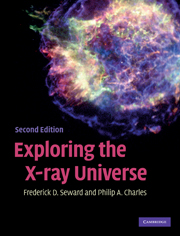Book contents
- Frontmatter
- Contents
- List of acronyms
- Foreword
- Chapter 1 Birth and childhood of X-ray astronomy
- Chapter 2 X-ray emission and interaction with matter
- Chapter 3 Tools and techniques
- Chapter 4 Solar system X-rays
- Chapter 5 X-ray absorption and scattering in the Interstellar Medium
- Chapter 6 Active stellar coronae
- Chapter 7 Early-type stars
- Chapter 8 Supernova explosions and their remnants
- Chapter 9 Neutron stars, pulsars, pulsar wind nebulae, and more supernova remnants
- Chapter 10 Cataclysmic variable stars
- Chapter 11 X-ray binaries
- Chapter 12 Black-hole X-ray binaries
- Chapter 13 Normal and starburst galaxies
- Chapter 14 Active galactic nuclei
- Chapter 15 Clusters of galaxies
- Chapter 16 The diffuse X-ray background
- Chapter 17 Gamma-ray bursts
- Index
- Plate section
Chapter 17 - Gamma-ray bursts
Published online by Cambridge University Press: 05 June 2012
- Frontmatter
- Contents
- List of acronyms
- Foreword
- Chapter 1 Birth and childhood of X-ray astronomy
- Chapter 2 X-ray emission and interaction with matter
- Chapter 3 Tools and techniques
- Chapter 4 Solar system X-rays
- Chapter 5 X-ray absorption and scattering in the Interstellar Medium
- Chapter 6 Active stellar coronae
- Chapter 7 Early-type stars
- Chapter 8 Supernova explosions and their remnants
- Chapter 9 Neutron stars, pulsars, pulsar wind nebulae, and more supernova remnants
- Chapter 10 Cataclysmic variable stars
- Chapter 11 X-ray binaries
- Chapter 12 Black-hole X-ray binaries
- Chapter 13 Normal and starburst galaxies
- Chapter 14 Active galactic nuclei
- Chapter 15 Clusters of galaxies
- Chapter 16 The diffuse X-ray background
- Chapter 17 Gamma-ray bursts
- Index
- Plate section
Summary
Discovery
In 1963, to lessen the rapid proliferation of nuclear weapons, the United States and the Soviet Union signed a treaty prohibiting testing such weapons in the atmosphere and in space. To assure that there were no violations of this treaty, in the late 1960s the United States deployed a series of spacecraft, the Vela satellites, as monitors. Several spacecraft were positioned so that all of near- Earth space was always viewed by at least one set of detectors.
A nuclear explosion in space produces an intense prompt burst of X-rays, neutrons and γ rays. This signal is bright enough, and with a distinctive enough time signature, that there should be no confusion with natural events. Also, as in a supernova explosion, debris is ejected in all directions at high velocity. The primary detectors on the Vela spacecraft were designed to detect and recognise the prompt signals. Still, a clandestine test might be hidden from the promptburst detectors by detonating the device behind the Moon. The debris, however, which contains highly radioactive, rapidly decaying fission fragments, would be thrown from the vicinity of the explosion and free of the Moon's shadow. Gamma-ray detectors were therefore included which were capable of detecting radiation from nuclear debris.
In 1972, after 3 years of operation, the Los Alamos group responsible for the various detectors realised that the system was detecting bursts of γ rays that were real events, not some strange combination of background noise.
- Type
- Chapter
- Information
- Exploring the X-ray Universe , pp. 340 - 353Publisher: Cambridge University PressPrint publication year: 2010



